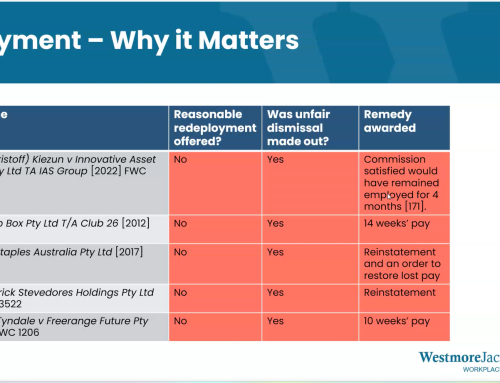 Medical practices can engage practitioners under a variety of contracting arrangements. In our experience, many practices are not clear regarding the type of contracting arrangement under which their practitioners are engaged.
Medical practices can engage practitioners under a variety of contracting arrangements. In our experience, many practices are not clear regarding the type of contracting arrangement under which their practitioners are engaged.
This can lead to confusion around how the customs and procedures of the business are or should be managed. In some instances, medical practices inadvertently treat their practitioners like employees although they are purportedly independent professionals or contractors. This creates legal risk, which if not carefully managed can prove costly.
This article outlines why it is important to ensure that your customs and procedures reflect the contractual arrangement your practitioners are engaged under.
Common contracting arrangements
The first step is to understand which legal relationship is, or should be, in place with your practitioners. Common contracting arrangements in medical practices include:
- Service arrangements: This is where the practice (or service entity) acts as a service provider to the practitioner. The practice supplies the premises, administrative support and resources to the practitioner in return for payment of a “service fee” from the practitioner. The practitioner carries out a business of their own, and are at no time contracted to perform “work” for the practice.
- Independent contractor: This is where the practice contracts with the practitioner to provide services to the medical practice. It is a contract “for services”, in that the practitioner carries on their own independent business and provides services to the practice;
- Employment: This is where the practitioner is employed by the practice to work for the practice. This is a contract “of service” where the practitioner serves the employer’s business and its best interests.
Remuneration, tax arrangements and legal liabilities differ between each arrangement.
Difficulties can arise where there is no clear understanding of the distinction between these types of contracting arrangements. Medical practices might be of the view that they have a service arrangement or independent contractor arrangement in place, but might, be treating and presenting their practitioners as employees of the practice.
Why does it matter?
If the appropriate arrangements are not in place it can increase the likelihood that practitioners may be held to be employees, and consequently, be eligible for legal entitlements as such. These can include:
- Leave entitlements;
- Superannuation entitlements;
- Workers’ compensation payments; and
- Protection from unfair dismissal.
Employers also have a number of additional responsibilities. These include:
- Income tax;
- WorkCover insurance premiums;
- Vicarious liability (as a general rule, employers are vicariously liable for the negligent acts of their employees); and
- Penalties if engaging in sham contracting.
Employment indicators
Determining what type of contractual arrangement is in place involves looking at the true nature of the relationship rather than the label used by the practice. There is no single factor or set of factors in determining whether someone is an employee. Rather, the courts apply a “multi-factor” approach.
A number of cases have considered whether a medical practice or health service was, at law, engaging their practitioners as employees, notwithstanding the practice had labelled the practitioners as contractors. These cases show that the following factors, amongst others, can be indicators of employment:
- The practitioner being forbidden from providing services to other medical practices;
- The practice exercising a high degree of control over how the practitioner performs their work;
- The practitioner not being permitted to retain patient records (this is relevant to goodwill);
- The practitioner not being permitted to arrange a locum to substitute for them;
- The practitioner being placed on a fixed roster; and
- The practice paying superannuation to the practitioner.
These factors show that arrangements where the practice has a high degree of control over the practitioner are at risk of being considered an employment relationship.
Having a well-drafted contract will be of assistance in clarifying the relationship. But a well-drafted contract will not be enough if your practice’s customs and procedures suggest the existence of an employment relationship.
Case study: Aufgang v Kozminksy Nominees
In Aufgang v Kozminsky Nominees Pty Ltd
Part of Dr Aufgang’s claim was that he was, at law, an employee. Accordingly, he claimed entitlements to unpaid annual leave and public holidays in accordance with statutory employee entitlements.
Kozminsky Nominees argued he was not entitled to employee entitlements because he was an independent contractor.
In deciding whether Dr Aufgang was an employee, the Court weighed up various factors.
Dr Aufgang had worked with the practice for eight years, rather than for himself or others. While it was not expressly stated, there was an expectation that he would give exclusive service to the business.
Kozminsky Nominees also conceded that if Dr Aufgang had worked elsewhere “he would have been using [Kozminksy’s] goodwill”. The Court held that Dr Aufgang had no rights over the patient goodwill he generated. This was indicative of an employment relationship.
Payment arrangements were also considered. Whilst Dr Aufgang received a percentage of billings, this was a neutral factor, the Court noting that both employees and contractors can be paid based on “results” rather than a wage.
The Court accepted Kozminsky Nominees decided who did what in the practice, and maintained the right to exercise control as necessary. While Dr Aufgang could exercise discretion in the way he carried out his clinical work, the Court observed that this type of discretion is to be expected of medical professionals and was not a clear indicator of an independent contractor relationship.
After considering these and other factors, the Court found that Dr Aufgang “was not carrying on a business of his own”. Instead, he was an employee.
Consequently, Dr Aufgang was entitled to a number of employee entitlements which had not been paid. For annual leave alone, he was entitled to $120,516.88.
This case shows importance of ensuring that your customs and procedures align with the type of contracting arrangement you say exist between your practice and each practitioner. A mere assertion that a practitioner is a contractor is insufficient.
Conclusion: updating your customs and procedures
This case, and others like it, show the importance of having the correct customs and procedures in place to help reduce the risk that your practitioners may be deemed employees at law. There should be a practical alignment between these customs and procedures, and the terms of your contracting arrangements. A contract labelling a practitioner a “contractor” is not enough.
A number of simple and practical changes can be made. For example, updating the language that describes practitioners on your website, ensuring invoices accurately reflect the legal relationship, and managing access to patient records when a practitioner leaves.
If you have questions about your customs and procedures, and the impact this may have on your medical practice, please contact on Adam Colquhoun on (03) 9499 9141 or by email at acolquhoun@westmorejacobs.com.au
Adam Colquhoun, Principal
Katherine Stewart, Senior Law Clerk
This article is general information only. It is not legal advice. If you need legal advice, please contact us.






Leave A Comment